macro polo biatch
1/104
There's no tags or description
Looks like no tags are added yet.
Name | Mastery | Learn | Test | Matching | Spaced |
|---|
No study sessions yet.
105 Terms
1. Recession come at
a. regular intervals. During recessions consumption spending falls relatively more than
investment spending.
b. regular intervals. During recessions investment spending falls relatively more than
consumption spending.
c. irregular intervals. During recessions consumption spending falls relatively more than
investment spending.
d. irregular intervals. During recessions investment spending falls relatively more than
consumption spending.
irregular intervals. During recessions investment spending falls relatively more than consumption spending.
During recessions investment
a. falls by a larger percentage than GDP.
b. falls by about the same percentage as GDP.
c. falls by a smaller percentage than GDP.
d. falls but the percentage change is sometimes much larger and sometimes much smaller.
falls by a larger percentage than GDP.
3. Real and nominal variables are highly intertwined, and changes in the money supply change real GDP. Most
economists would agree that this statement accurately describes
a. both the short run and the long run.
b. the short run, but not the long run.
c. the long run, but not the short run.
d. neither the long run nor the short run.
the short run, but not the long run.
The model of short-run economic fluctuations focuses on the price level and
a. real GDP.
b. economic growth.
c. the neutrality of money.
d. None of the above is correct
real GDP.
The aggregate demand and aggregate supply graph has
a. quantity of output on the horizontal axis. Output can be measured by the GDP deflator.
b. quantity of output on the horizontal axis. Output can be measured by real GDP.
c. quantity of output on the vertical axis. Output can be measured by the GDP deflator.
d. quantity of output on the vertical axis. Output can be measured by real GDP.
quantity of output on the horizontal axis. Output can be measured by real GDP.
Aggregate demand includes
a. only the quantity of goods and services households want to buy.
b. only the quantity of goods and services households and firms want to buy.
c. only the quantity of goods and services households, firms, and the government want to
buy.
d. the quantity of goods and services households, firms, the government, and customer
abroad want to buy.
the quantity of goods and services households, firms, the government, and customers abroad want to buy.
Which of the sentences concerning the aggregate demand and aggregate supply model is correct?
a. The aggregate demand and aggregate supply model is nothing more than a large version
of the model of market demand and supply.
b. The price level and quantity of output adjust to bring aggregate demand and supply into
balance.
c. The aggregate supply curve shows the quantity of goods and services that households,
firms, and the government want to buy at each price.
d. All of the above are correct.
The price level and quantity of output adjust to bring aggregate demand and supply into balance.
Which of the following is not included in aggregate demand?
a. purchases of stock and bonds
b. purchases of services such as visits to the doctor
c. purchases of capital goods such as equipment in a factory
d. purchases by foreigners of consumer goods produced in the United States
purchases of stock and bonds
The aggregate quantity of goods and services demanded changes as the price level rises because
a. real wealth falls, interest rates rise, and the dollar appreciates.
b. real wealth falls, interest rates rise, and the dollar depreciates.
c. real wealth rises, interest rates fall, and the dollar appreciates.
d. real wealth rises, interest rates fall, and the dollar depreciates.
real wealth falls, interest rates rise, and the dollar appreciates.
Other things the same, when the price level rises, interest rates
a. rise, so firms increase investment.
b. rise, so firms decrease investment.
c. fall, so firms increase investment.
d. fall, so firms decrease investment.
rise, so firms decrease investment.
Other things the same, if the price level rises, then domestic interest rates
a. rise, so domestic residents will want to hold more foreign bonds.
b. rise, so domestic residents will want to hold fewer foreign bonds.
c. fall, so domestic residents will want to hold more foreign bonds.
d. fall, so domestic residents will want to hold fewer foreign bonds.
rise, so domestic residents will want to hold fewer foreign bonds.
As the price level falls,
a. the exchange rate falls, so net exports fall.
b. the exchange rate falls, so net exports rise.
c. the exchange rate rises, so net exports fall.
d. the exchange rate rises, so net exports rise.
the exchange rate falls, so net exports rise.
Which of the following will both make people spend more?
a. wealth and interest rates rise.
b. wealth rises and interest rates fall.
c. wealth falls and interest rates rise.
d. wealth falls and interest rates fall.
wealth rises and interest rates fall.
Suppose a fall in stock prices makes people feel poorer. The decrease in wealth would induce people to
desire
a. decreased consumption, shown as a movement to the left along a given
aggregate-demand curve.
b. increase consumption, shown as a movement to the right along a given
aggregate-demand curve.
c. decreased consumption, shifting the aggregate-demand curve to the left.
decreased consumption, shifting the aggregate-demand curve to the left.
When taxes increase, consumption
a. increases, so aggregate demand shifts right.
b. increases, so aggregate supply shifts right.
c. decreases, so aggregate demand shifts left.
d. decreases, so aggregate supply shifts left.
decreases, so aggregate demand shifts left.
Which of the following shifts aggregate demand to the left?
a. an increase in the price level
b. a decrease in the money supply
c. an increase in net exports
d. Congress passes a new investment tax credit
a decrease in the money supply.
The long-run aggregate supply curve shifts right if
a. immigration from abroad increases.
b. the capital stock increases.
c. technology advances.
d. All of the above are correct.
All of the above are correct.
The discovery of a large amount of previously-undiscovered oil in the U.S. would shift
a. the long-run aggregate-supply curve to the right.
b. the long-run aggregate-supply curve to the left.
c. the aggregate-demand curve to the left.
d. None of the above is correct
the long-run aggregate-supply curve to the right.
The sticky-wage theory of the short-run aggregate supply curve says that the quantity of output firms supply
will increase if
a. the price level is higher than expected making production more profitable.
b. the price level is higher than expected making production less profitable.
c. the price level is lower than expected making production more profitable.
d. the price level is higher than expected making production less profitable
the price level is higher than expected making production more profitable.
Other things the same, if the price level rises by 2% and people were expecting it to rise by 5%, then some
firms have
a. higher than desired prices which increases their sales.
b. higher than desired prices which depresses their sales.
c. lower than desired prices which increases their sales.
d. lower than desired prices which depresses their sales.
higher than desired prices which depresses their sales.
A decrease in the expected price level shifts
a. only the long-run aggregate supply curve right.
b. only the short-run aggregate supply curve right.
c. both the short-run and the long-run aggregate supply curve right.
d. Neither the short-run nor the long-run aggregate supply curve right.
only the short-run aggregate supply curve right.
Which of the following would cause prices to fall and output to rise in the short run?
a. Short-run aggregate supply shifts right.
b. Short-run aggregate supply shifts left.
c. Aggregate demand shifts right.
d. Aggregate demand shifts left.
Short-run aggregate supply shifts right.
Policymakers who control monetary and fiscal policy and want to offset the effects on output of an economic
contraction caused by a shift in aggregate supply could use policy to shift
a. aggregate supply to the right.
b. aggregate supply to the left.
c. aggregate demand to the right.
d. aggregate demand to the left.
aggregate demand to the right.
When production costs rise,
a. the short-run aggregate supply curve shifts to the right.
b. the short-run aggregate supply curve shifts to the left.
c. the aggregate demand curve shifts to the right.
d. the aggregate demand curve shifts to the left
the short-run aggregate supply curve shifts to the left.
Stagflation exists when prices
a. and output rise.
b. rise and output falls.
c. fall and output rises.
d. and output fall.
rise and output falls.
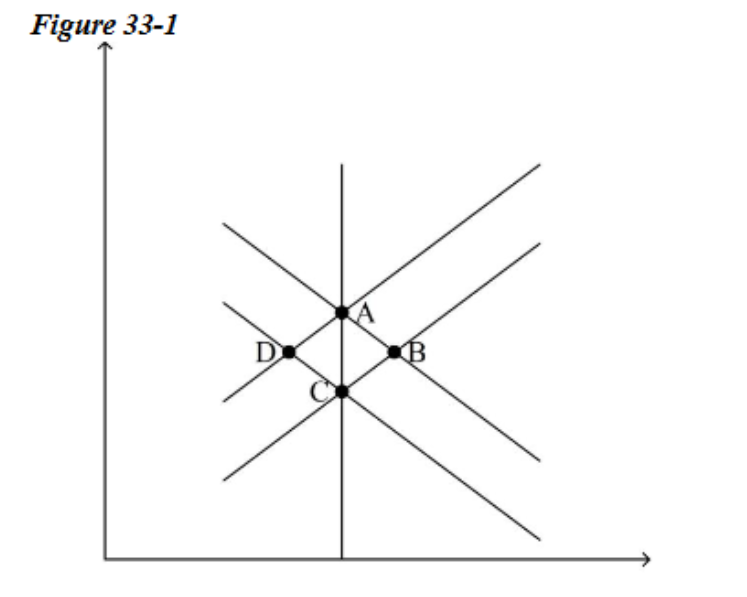
Refer to Figure 33-1. An increase in the money supply would move the economy from C to
a. B in the short run and the long run.
b. D in the short run and the long run.
c. B in the short run and A in the long run.
d. D in the short run and C in the long run.
B in the short run and A in the long run.
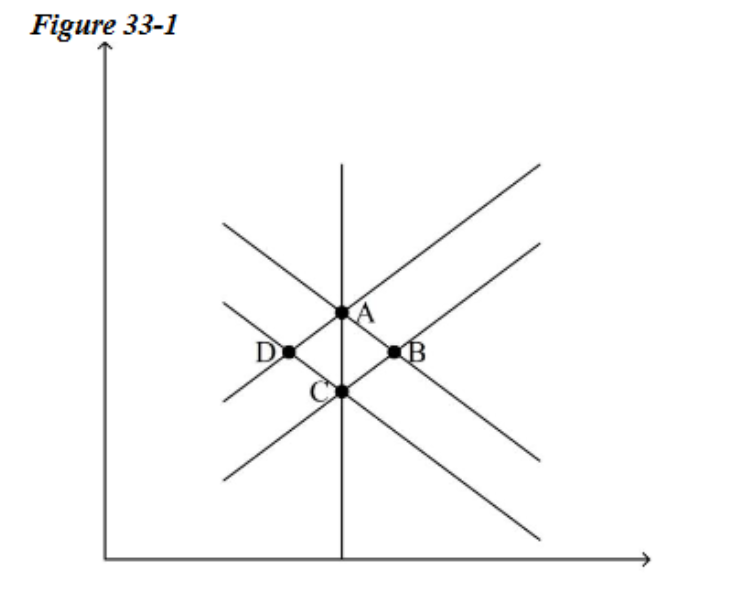
Refer to Figure 33-1. If the economy starts at C, an increase in the money supply moves the economy
a. to A in the long run.
b. to B in the long run.
c. back to C in the long run.
d. to D in the long run.
to A in the long run.
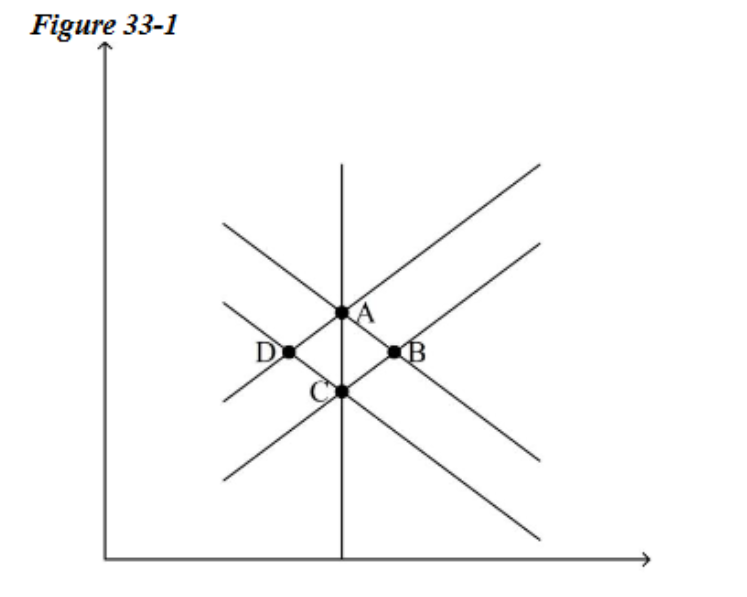
Refer to Figure 33-1. If the economy is at A and there is a fall in aggregate demand, in the short run the
economy
a. stays at A.
b. moves to B.
c. moves to C.
d. moves to D.
moves to D.
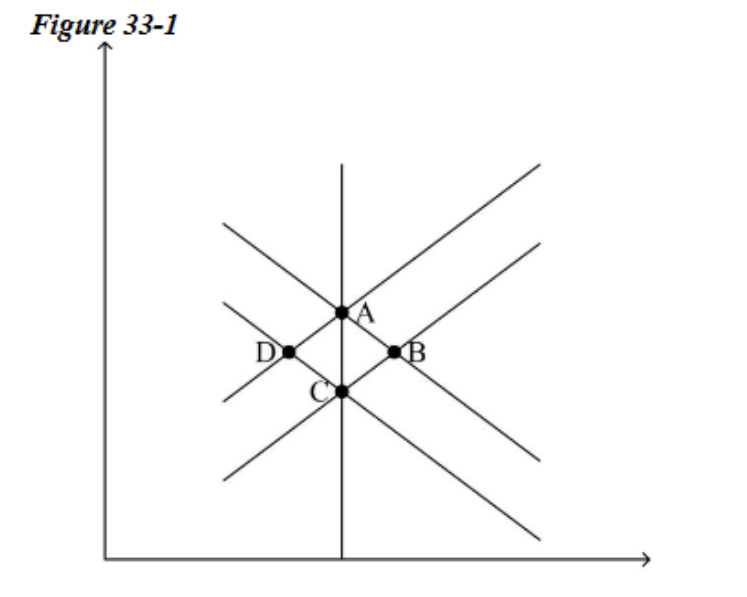
Refer to Figure 33-1. If the economy starts at A and there is a fall in aggregate demand, the economy moves
a. back to A in the long run.
b. to B in the long run.
c. to C in the long run.
d. to D in the long run
to C in the long run.
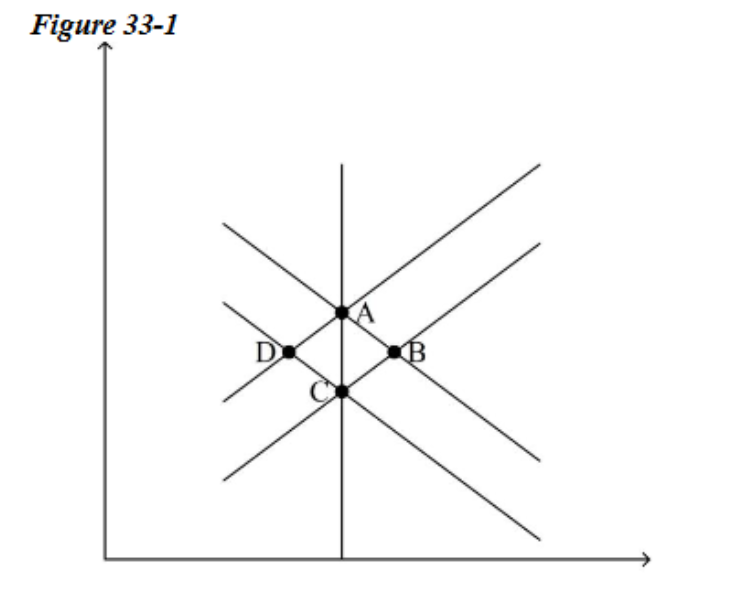
Refer to Figure 33-1. If the economy starts at A and moves to D in the short run, the economy
a. moves to A in the long run.
b. moves to B in the long run.
c. moves to C in the long run.
d. stays at D in the long run.
moves to C in the long run.
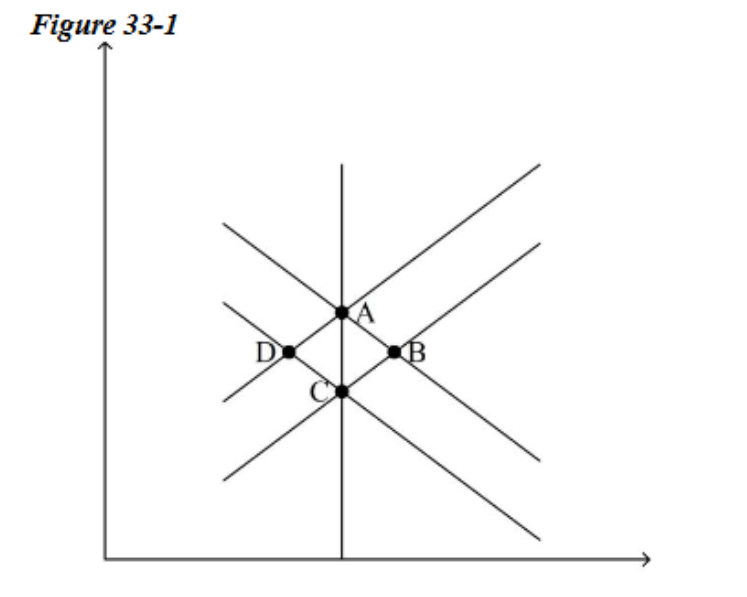
Refer to Figure 33-1. The economy would be moving to long-run equilibrium if it started at
a. A and moved to B.
b. C and moved to B.
c. D and moved to C.
d. None of the above is correct.
D and moved to C.
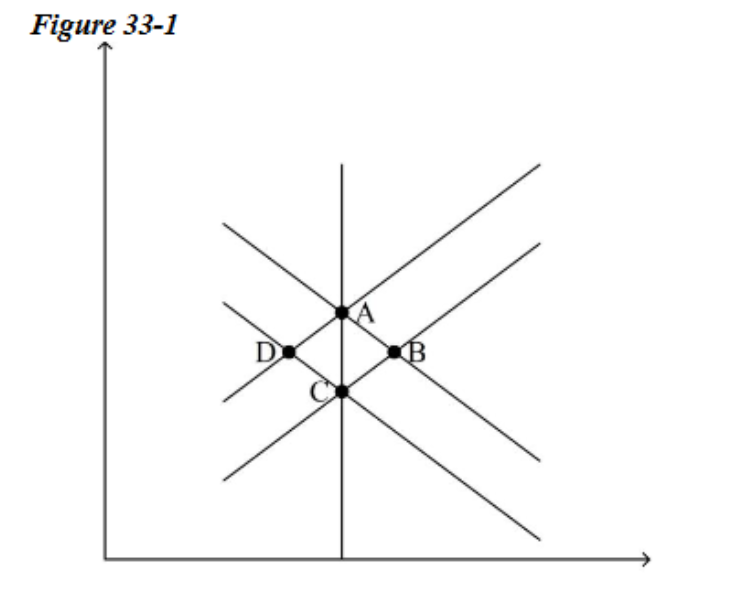
Refer to Figure 33-1. If the economy is in long-run equilibrium, then an adverse shift in aggregate supply
would move the economy from
a. A to B.
b. C to D.
c. B to A.
d. D to C.
A to B.

Refer to Figure 33-1. In the short run, a favorable shift in aggregate supply would move the economy from
a. A to B.
b. B to C.
c. C to D.
d. D to A.
A to B.
Suppose the economy is in long-run equilibrium. Senator A succeeds in getting taxes raised. At the same
time, Senator B succeeds in getting major new restrictions on logging enacted. In the short run
a. real GDP will rise and the price level might rise, fall, or stay the same.
b. real GDP will fall and the price level might rise, fall, or stay the same.
c. the price level will rise, and real GDP might rise, fall, or stay the same.
d. the price level will fall, and real GDP might rise, fall, or stay the same.
real GDP will fall and the price level might rise, fall, or stay the same.
Suppose the economy is in long-run equilibrium. In a short span of time, there is a decline in the money
supply, a tax increase, a pessimistic revision of expectations about future business conditions, and a rise in
the value of the dollar. In the short run, we would expect
a. the price level and real GDP both to rise.
b. the price level and real GDP both to fall.
c. the price level and real GDP both to stay the same.
d. All of the above are possible.
the price level and real GDP both to fall.
Fiscal policy affects the economy
a. only in the short run.
b. only in the long run.
c. in both the short and long run.
d. in neither the short nor the long run.
in both the short and long run.
Which of the following shifts aggregate demand to the left?
a. an increase in the price level
b. an increase in the money supply
c. a decrease in the price level
d. a decrease in the money supply
a decrease in the money supply
If the Fed conducts open-market purchases, the money supply
a. increases and aggregate demand shifts right.
b. increases and aggregate demand shifts left.
c. decreases and aggregate demand shifts right.
d. decreases and aggregate demand shifts left
increases and aggregate demand shifts right.
If the Fed conducts open-market purchases, then which of the following quantities increase(s)?
a. interest rates, prices, and investment spending
b. interest rates and prices, but not investment spending
c. prices and investment spending, but not interest rates
d. interest rates, but not prices or investment spending
prices and investment spending, but not interest rates.
If the stock market crashes, then
a. aggregate demand increases, which the Fed could offset by increasing the money supply.
b. aggregate demand increases, which the Fed could offset by decreasing the money supply.
c. aggregate demand decreases, which the Fed could offset by increasing the money supply.
d. aggregate demand decreases, which the Fed could offset by decreasing the money
supply
aggregate demand decreases, which the Fed could offset by increasing the money supply.
Suppose that the Federal reserve is concerned about the effects of rising stock prices on the economy. What
could it do?
a. buy bond to raise the interest rate
b. buy bonds to lower the interest rate
c. sell bonds to raise the interest rate
d. sell bonds to lower the interest rate
sell bonds to raise the interest rate.
When the Fed decreases the money supply, we expect
a. interest rates and stock prices to rise.
b. interest rates and stock prices to fall.
c. interest rates to rise and stock prices to fall.
d. interest rates to fall and stock prices to rise
interest rates to rise and stock prices to fall.
In the long run, fiscal policy primarily affects
a. aggregate demand. In the short run, it affects primarily aggregate supply.
b. aggregate supply. In the short run, it affects primarily saving, investment, and growth.
c. saving, investment, and growth. In the short run, it affects primarily aggregate demand.
d. saving, investment, and growth. In the short run, it affects primarily aggregate supply
saving, investment, and growth. In the short run, it affects primarily aggregate demand.
The multiplier effect is exemplified by the multiplied impact on
a. the money supply of a given increase in government purchases.
b. tax revenues of a given increase in government purchases.
c. investment of a given increase in interest rates.
d. aggregate demand of a given increase in government purchases
aggregate demand of a given increase in government purchases.
The term crowding-out effect refers to
a. the reduction in aggregate supply that results when a monetary expansion causes the
interest rate to decrease.
b. the reduction in aggregate demand that results when a monetary expansion causes the
interest rate to decrease.
c. the reduction in aggregate demand that results when a fiscal expansion causes the
interest rate to increase.
d. the reduction in aggregate demand that results when a decrease in government spending
or an increase in taxes causes the interest rate to increase
the reduction in aggregate demand that results when a fiscal expansion causes the interest rate to increase.
Most economists believe that fiscal policy
a. only affects aggregate demand and not aggregate supply.
b. primarily affects aggregate demand.
c. primarily effects aggregate supply.
d. only affects aggregate supply and not aggregate demand.
primarily affects aggregate demand.
Supply-side economists believe that changes in government purchases affect
a. only aggregate demand.
b. only aggregate supply.
c. both aggregate demand and aggregate supply.
d. neither aggregate demand nor aggregate supply
both aggregate demand and aggregate supply.
If Congress cuts spending to balance the federal budget, the Fed can act to prevent unemployment and
recession by
a. buying bonds to increase the money supply
b. buying bonds to decrease the money supply.
c. selling bonds to increase the money supply.
d. selling bonds to decrease the money supply.
buying bonds to increase the money supply.
Suppose there were a large increase in net exports. If the Fed wanted to stabilize output, it could
a. buy bonds to increase the money supply.
b. buy bonds to decrease the money supply.
c. sell bonds to increase the money supply.
d. sell bonds to decrease the money supply.
buy bonds to increase the money supply.
During periods of expansion, automatic stabilizers cause government expenditures
a. and taxes to fall.
b. and taxes to rise.
c. to rise and taxes to fall.
d. to fall and taxes to rise
and taxes to rise.
The primary argument against active monetary and fiscal policy is that
a. attempts to stabilize the economy do not constitute a proper role for government in a
democratic society.
b. these policies affect the economy with a long lag.
c. these policies affect the economy too quickly and with too much impact.
d. history demonstrates that interest rates respond unpredictably to active policies, leading
to unpredictable effects on income.
these policies affect the economy with a long lag.
Other things the same, during recessions taxes tend to
a. rise. The rise in taxes stimulates aggregate demand.
b. rise. The rise in taxes contracts aggregate demand.
c. fall. The fall in taxes stimulates aggregate demand.
d. fall. The fall in taxes contracts aggregate demand.
fall. The fall in taxes stimulates aggregate demand.
Which type(s) of economies interact with other economies?
a. only closed economies
b. only open economies
c. closed economies and open economies
d. neither closed nor open economies
only open economies.
When Claudia, a U.S. citizen, purchases a handbag made in France, the purchase is
a. both a U.S. and French import.
b. a U.S. export and a French import.
c. a U.S. import and a French export.
d. neither an export nor an import for either country.
a U.S. import and a French export.
Oceania buys $40 of wine from Escudia and Escudia buys $100 of wool from Oceania. Supposing this is the
only trade that these countries do. What are the net exports of Oceania and Escudia in that order?
a. $140 and $140
b. $100 and $40
c. $60 and -$60
d. None of the above is correct
$60 and -$60
Refer to Table 31-1. What are Argentina’s exports?
a. $60 billion
b. $35 billion
c. $10 billion
d. None of the above are correct.
$35 billion
Refer to Table 31-1. What are Argentina’s imports?
a. $60 billion
b. $35 billion
c. $40 billion
d. None of the above are correct.
$60 billion
Refer to Table 31-1. What are Argentina’s net exports?
a. $30 billion
b. $5 billion
c. -$5 billion
d. -$25 billion
-$25 billion (Net exports = Exports – Imports)
A U.S. firm buys bonds issued by a technology center in India. This purchase is an example of U.S.
a. foreign portfolio investment. By itself it is an increase in U.S. holdings of foreign bonds
and increases U.S. net capital outflow.
b. foreign portfolio investment. By itself it is an increase in U.S. holdings of foreign bonds
and decreases U.S. net capital outflow.
c. foreign direct investment. By itself it is an increase in U.S. holdings of foreign bonds
and increases U.S. net capital outflow.
d. foreign direct investment. By itself it is an increase in U.S. holdings of foreign bonds
and decreases U.S. net capital outflow.
foreign portfolio investment. By itself it is an increase in U.S. holdings of foreign bonds
and increases U.S. net capital outflow.
Bob, a Greek citizen, opens a restaurant in Chicago. His expenditures
a. increase U.S. net capital outflow and have no affect on Greek net capital outflow.
b. increase U.S. net capital outflow and increase Greek net capital outflow.
c. increase U.S. net capital outflow, but decrease Greek net capital outflow.
d. decrease U.S. net capital outflow, but increase Greek net capital outflow.
decrease U.S. net capital outflow, but increase Greek net capital outflow.
U.S. based John Deere sells machinery to residents of South Africa who pay with South African
currency (the rand).
a. This increases U.S. net capital outflow because the U.S. acquires foreign assets.
b. This decreases U.S. net capital outflow because the U.S. acquires foreign assets.
c. This increases U.S. net capital outflow because the U.S. sells capital goods.
d. This decreases U.S. net capital outflow because the U.S. sells capital goods
This increases U.S. net capital outflow because the U.S. acquires foreign assets.
If there is a trade deficit, then
a. saving is greater than domestic investment and Y > C + I + G.
b. saving is greater than domestic investment and Y < C + I + G.
c. saving is less than domestic investment and Y > C +I + G.
d. saving is less than domestic investment and Y < C + I + G
saving is less than domestic investment and Y < C + I + G.
Other things the same, if a country saves less, then
a. net capital outflow rises, so net exports rise.
b. net capital outflow rises, so net exports fall.
c. net capital outflow falls, so net exports rise.
d. net capital outflow falls, so net exports fall.
net capital outflow falls, so net exports fall.
A country has $60 million of saving and domestic investment of $40 million. Net exports are
a. $20 million.
b. -$20 million.
c. $100 million.
d. -$100 million.
$20 million.
In an open economy, gross domestic product equals $2,450 billion, consumption expenditure equals $1,390
billion, government expenditure equals $325 billion, investment equals $510 and net capital outflow equals
$225 billion. What is national saving?
a. $225 billion
b. $510 billion
c. $735 billion
d. $1,390 billion
$735 billion (GDP (Y) = $2,450 billion
Consumption (C) = $1,390 billion
Government spending (G) = $325 billion
Investment (I) = $510 billion
Net capital outflow (NCO) = $225 billion (which equals Net Exports, NX, in an open economy)
So:
S=Y−C−G=2,450−1,390−325=735S = Y - C - G = 2,450 - 1,390 - 325 = 735S=Y−C−G=2,450−1,390−325=735)
The nominal exchange rate is the
a. nominal interest rate in one country divided by the nominal interest rate in the other
country.
b. the ratio of a foreign country’s interest rate to the domestic interest rate.
c. rate at which a person can trade the currency of one country for another.
d. the real exchange rate minus the inflation rate.
rate at which a person can trade the currency of one country for another.
If the exchange rate is 125 yen = $1, a bottle of rice wine that costs 2,500 yen costs
a. $20.
b. $25.
c. $22.
d. None of the above is correct
$20. Price in dollars= 2,500 yen/125 yen=20 dollars
You are planning a graduation trip to Nepal. Other things the same, if the dollar appreciates relative to the
Nepalese rupee, then
a. the dollar buys fewer rupees. Your purchases in Nepal will require fewer dollars.
b. the dollar buys fewer rupees. Your purchases in Nepal will require more dollars.
c. the dollar buys more rupees. Your purchases in Nepal will require fewer dollars.
d. the dollar buys more rupees. Your purchases in Nepal will require more dollars.
the dollar buys more rupees. Your purchases in Nepal will require fewer dollars.
Other things the same, if the exchange rate changes from 125 yen per dollar to 115 yen per dollar, the dollar
has
a. appreciated and so buys more Japanese goods.
b. appreciated and so buys fewer Japanese goods.
c. depreciated and so buys more Japanese goods.
d. depreciated and so buys fewer Japanese goods.
depreciated and so buys fewer Japanese goods.
If the exchange rate is 5 units of Peruvian currency per dollar and a hotel room in Lima costs 300 units of
Peruvian currency, then how many dollars do you need to get a room?
a. 1,500, and your purchase will increase Peru's net exports.
b. 60 and your purchase will increase Peru's net exports.
c. 1,500 and your purchase will have no effect on Peru's net exports.
d. 60 and your purchase will have no effect on Peru's net exports
60 and your purchase will increase Peru's net exports.
The exchange rate is 1.5 Bosnian markas per U.S. dollar. The price of a refrigerator in Bosnia is 1,200
markas while in the U.S. it is $1,000. The real exchange rate is
a. 9/5
b. 5/4
c. 4/5
d. None of the above are correct.
9/5
In the United States, a three-pound can of coffee costs about $5. If the exchange rate is about 0.6 euros per
dollar and a three-pound can of coffee in Belgium costs about 4 euros. What is the real exchange rate?
a. 5/4 cans of Belgian coffee per can of U.S. coffee
b. 4/3 cans of Belgian coffee per can of U.S. coffee
c. 4/5 cans of Belgian coffee per can of U.S. coffee
d. 3/4 cans of Belgian coffee per can of U.S. coffee
4/5 cans of Belgian coffee per can of U.S. coffee
A depreciation of the U.S. real exchange rate induces U.S. consumers to buy
a. fewer domestic goods and fewer foreign goods.
b. more domestic goods and fewer foreign goods.
c. fewer domestic goods and more foreign goods.
d. more domestic goods and more foreign goods.
more domestic goods and fewer foreign goods.
If the real exchange rate between the U.S. and Argentina is 1, then
a. purchasing-power parity holds, and 1 U.S. dollar buys 1 Argentinean bolivar.
b. purchasing power parity holds, and the amount of dollars needed to buy goods in the
U.S. is the same as the amount needed to buy enough Argentinean bolivars to buy the
same goods in Argentina.
c. purchasing power parity does not hold, but 1 U.S. dollar buys 1 Argentinean bolivar.
d. purchasing power parity does not hold, but the amount of dollars needed to buy goods in
the U.S. is the same as the amount needed to buy enough Argentinean bolivars to buy the
same goods in Argentina.
purchasing power parity holds, and the amount of dollars needed to buy goods in the U.S. is the same as the amount needed to buy enough Argentinean bolivars to buy the same goods in Argentina.
Suppose a Starbucks tall-latte cost $4.00 in the United States and 3.20 euros in the Euro area. Also, suppose a
McDonald’s Big Mac costs $3.50 in the United States and 2.45 euros in Euro area. If the nominal exchange
rate is .80 euros per dollar, which goods have prices that are consistent with purchasing power parity?
a. Both the tall-latte and the Big Mac.
b. Neither the tall-latte nor the Big Mac.
c. The tall-latte but not the Big Mac.
d. The Big Mac but not the tall-latte
The tall-latte but not the Big Mac.
During some year a country had exports of $50 billion, imports of $35 billion, and purchased $30 billion of foreign assets. What was the value of domestic assets purchased by foreigners?
$5 billion
$20 billion
$35 billion
$15 billion
$15 billion
If purchasing-power parity holds, a dollar will buy
as many goods in foreign countries as it does in the United States.
more goods in foreign countries than in the United States.
fewer goods in foreign countries than it does in the United States.
None of the other choices is implied by purchasing-power parity.
1.as many goods in foreign countries as it does in the United States.
The nominal exchange rate is the
rate at which a person can trade the currency of one country for another.
the ratio of a foreign country’s interest rate to the domestic interest rate.
nominal interest rate in one country divided by the nominal interest rate in the other country.
the real exchange rate minus the inflation rate.
1.
Domestic saving must equal domestic investment in
neither closed nor open economies.
open, but not closed economies.
closed, but not open economies.
both closed and open economies.
3
A Japanese firm buys lumber from the United States and pays for it with yen. Other things the same, Japanese
net exports increase, and U.S. net capital outflow decreases.
net exports decrease, and U.S. net capital outflow decreases.
net exports decrease, and U.S. net capital outflow increases.
net exports increase, and U.S. net capital outflow increases.
4
Sonya, a citizen of Denmark, produces boots and shoes that she sells to department stores in the United States. Other things the same, these sales
increase U.S. net exports and decrease Danish net exports.
decrease U.S. net exports and have no effect on Danish net exports.
decrease U.S. net exports and increase Danish net exports.
increase U.S. net exports and have no effect on Danish net exports.
3
In the U.S. a candy bar costs $1. The nominal exchange rate is 6 Chinese yuan per dollar. If the real exchange rate is 1.2, then, what is the price of a candy bar in China?
7.2 yuan
3.6 yuan
5 yuan
6 yuan
3
Other things the same, if the exchange rate changes from 41 Thai bhat per dollar to 35 Thai bhat per dollar, then the dollar has
depreciated and so buys more Thai goods.
depreciated and so buys fewer Thai goods.
appreciated and so buys more Thai goods.
appreciated and so buys fewer Thai goods.
2
If U.S. exports are $150 billion and U.S. imports are $100 billion, which of the following is correct?
The U.S. has a trade deficit of $50 billion.
The U.S. has a trade surplus of $100 billion.
The U.S. has a trade deficit of $100 billion.
The U.S. has a trade surplus of $50 billion.
4
Net capital outflow is defined as the purchase of
domestic assets by foreign residents minus the purchase of domestic goods and services by foreign residents.
domestic assets by foreign residents minus the purchase of foreign assets by domestic residents.
foreign assets by domestic residents minus the purchase of foreign goods and services by domestic residents.
foreign assets by domestic residents minus the purchase of domestic assets by foreign residents.
4
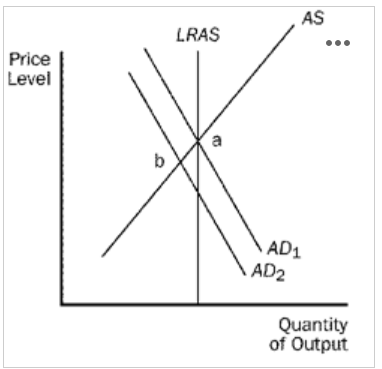
If the economy is at point b, a policy to restore full employment would be
a decrease in the money supply
a decrease in government purchases.
an increase in the money supply.
an increase in taxes.
3
If the Fed conducts open-market sales, the money supply
decreases and aggregate demand shifts right.
increases and aggregate demand shifts right.
decreases and aggregate demand shifts left.
increases and aggregate demand shifts left.
3
If the stock market crashes, then
aggregate demand decreases, which the Fed could offset by increasing the money supply.
aggregate demand increases, which the Fed could offset by increasing the money supply.
aggregate demand increases, which the Fed could offset by decreasing the money supply.
aggregate demand decreases, which the Fed could offset by decreasing the money supply.
1
Which of the following is not an automatic stabilizer?
the minimum wage
the welfare system
the federal income tax
the unemployment compensation system
1
Fiscal policy refers to the idea that aggregate demand is affected by changes in
interest rate policy
the money supply.
trade policy.
government spending and taxes.
4
In recent years, the Federal Reserve has conducted monetary policy by setting a target for
the exchange rate.
the monetary growth rate.
the federal funds rate.
bank reserves.
3
The multiplier effect
amplifies the effects of an increase in government expenditures, while the crowding-out effect diminishes the effects.
diminishes the effects of an increase in government expenditures, while the crowding-out effect amplifies the effects.
and the crowding-out effect both amplify the effects of an increase in government expenditures.
and the crowding-out effect both diminish the effects of an increase in government expenditures.
1
Permanent tax cuts shift the AD curve
farther to the left than do temporary tax cuts.
farther to the right than do temporary tax cuts.
not as far to the left as do temporary tax cuts.
not as far to the right as do temporary tax cuts.
2
Which of the following Fed actions would both increase the money supply?
buy bonds and lower the reserve requirement
buy bonds and raise the reserve requirement
sell bonds and raise the reserve requirement
sell bonds and lower the reserve requirement
1
Tax cuts
shift aggregate demand right while increases in government expenditures shift aggregate demand left.
and increases in government expenditures shift aggregate demand right.
and increases in government expenditures shift aggregate demand left.
shift aggregate demand left while increases in government expenditures shift aggregate demand right.
2
The sticky-wage theory of the short-run aggregate supply curve says that when the price level rises more than expected,
production is less profitable and employment rises.
production is less profitable and employment falls.
production is more profitable and employment falls.
production is more profitable and employment rises.
4
Other things the same, if the capital stock increases, then in the long run
output is higher and prices are lower.
both output and prices are lower.
both output and prices are higher.
output is lower and prices are higher.
1
Economic expansions in Germany and Japan would cause
the U.S. price level and real GDP to fall.
the U.S. price level and real GDP to rise.
the U.S. price level to fall and real GDP to rise.
the U.S. price level to rise and real GDP to fall.
2
The price level rises in the short run if
aggregate demand shifts left or aggregate supply shifts right.
aggregate demand or aggregate supply shifts right.
aggregate demand shifts right or aggregate supply shifts left.
aggregate demand or aggregate supply shifts right.
3
Which of the following shifts short-run, but not long-run aggregate supply right?
a decrease in the capital stock
a decrease in the expected price level
a decrease in the actual price level
an increase in the money supply
2